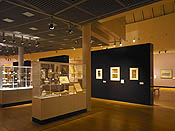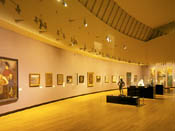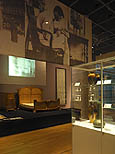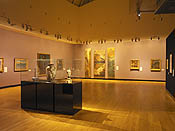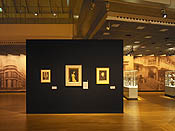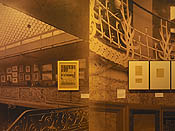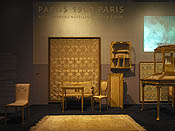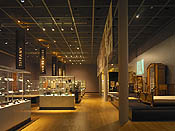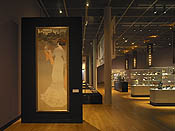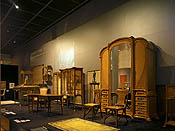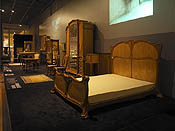|
 |
The Origins of L'Art Nouveau: The Bing Empire
Edited by Gabriel P. Weisberg, Edwin Becker, and Évelyne Possémé
Amsterdam: Van Gogh Museum, 2004.
295 pages
298 color illustrations, index, bibliography.
ISBN 90 6153 562 x
Hardcover: $69.95
Exhibition and catalogue:
Van Gogh Museum, Amsterdam, 26 November 2004 – 27 February 2005
Museum Villa Stuck, Munich, 17 March -31 July 2005
Caixa Forum, Barcelona, September 2005 – January 2006
Musée des Arts décoratifs, Brussels, March – July 2006
|
 |
|
|
|
|
|
|
This spectacular didactic exhibition and publication were organized by the Van Gogh Museum and the Musée des Arts décoratifs, and curated by Gabriel P. Weisberg, Edwin Becker and Évelyne Possémé, with selections on Oriental art by Christine Shimizu. My first thought was to entitle this review of the show at the Van Gogh Museum "Bing's Big Bang Blossoms at the Van Gogh;" however, after rereading the catalogue, I decided to call it "Japonisme and Bing Revisited." Indeed, the very premise of the exhibition is the essential connection that existed between Japanese art/Japonisme, and the development of Bing's form of art nouveau. In fact, it was thirty years ago, in 1975, that the Cleveland Museum, The Walters Art Gallery, and the Rutgers University Art Gallery [now Zimmerli Art Museum] presented the exhibition Japonisme: The Japanese Influence on French Art, 1854–1910, and it was nineteen years ago that the Smithsonian Institution organized the traveling exhibition in the U. S., Art Nouveau Bing, Paris Style 1900. Both of these seminal projects were led by Gabriel Weisberg and assisted, as always, by his partner in life and in research, Yvonne. It is in great part due to their scholarship and perseverance that Japonisme, and now Siegfried Bing, are universally recognized as major factors in not only French art of the second half of the nineteenth century, but in much of the art of the rest of Europe and of the United States as well. |
|
|
|
|
|
|
|
|
In 1988, Paris documented further the great impact that the art of Japan had on nineteenth-century art in France with the Grand Palais' exhibition, Le Japonisme, which subsequently traveled to Tokyo. The current exhibition, The Origins of L'Art Nouveau, The Bing Empire, finally pays homage in Europe to this important art dealer, connoisseur and entrepreneur, and in so doing, gives an abbreviated history of Japonisme while simultaneously documenting the vital role Bing played in the acquiring, dissemination and codification of Japanese art. The publication and exhibition are expanded versions of Weisberg's 1986 Smithsonian Bing project. Weisberg's text reflects much that he wrote nineteen years earlier: the history of Bing's successful German, Jewish, merchant family; its establishment of a Paris base in the 1850s and 1860s with the purchase of porcelain factories; Siegfried's subsequent control of the family's Paris business after the Franco-Prussian War; his French citizenship in 1876; his early contact with Japanese art in the late 1860s; his marketing of it in the 1870s; the opening of his shop on the rue Chauchut at the time of the 1878 Paris International Exhibition in which Japan and its art were a major attraction; his first trip to Japan in 1880 where he acquired antique as well as contemporary Japanese art; the development of contacts with agents in Japan and later the establishment of offices in Yokohama and Kobe; the expansion of his Japanese art sales to museums outside of France; Siegfried's Japonisme activities in the 1880s which brought him and his Japanese collection into contact with artists such as Van Gogh, and which culminated with the publication of his influential, internationally distributed journal, Le Japon artistique (1888-1891); and his participation in the organization of the major exhibition of Japanese prints at the Ecole des Beaux-Arts in the spring of 1890. Weisberg's chapters reiterate further: the history of Bing's trip in 1894 to the United States with his establishment of an in depth and long-term collaboration with Tiffany and American craftsmen for the production and selling of decorative arts in Europe, most importantly the stained-glass windows by members of the Nabis and Henri de Toulouse-Lautrec; the history of Bing's Art Nouveau Gallery on the rue de Provence [the part of his building attached to his Japanese shop around the corner on the rue Chauchat] which opened in December 1895 for the purpose of promoting a "new art" by an international coterie of avant-garde contemporary artists; and finally, the creation of artists/craftsmen workshops on the premises of the Art Nouveau Gallery, and of the Bing Pavilion at the 1900 Paris World Fair which promoted a consistent, decorative form of Art Nouveau dominated by the aesthetics of Eugène Gaillard, Edward Colonna, and Georges de Feure. |
|
|
|
|
|
|
|
|
Weisberg's chapters are well reinforced and complemented by those of the other authors. Christine Shimizu documents the actual kinds of Japanese art that, inspired by the 1867 World's Fair, Bing acquired early on such as bronzes, ceramics and prints; she also discusses the evolution in France of an accurate history and knowledge of Japanese art. Philippe Thiébaut puts the purpose and design of Bing's Art Nouveau Gallery into perspective with the aesthetic concerns and similar, earlier efforts in Brussels among members of Les XX and La Libre Esthétique. Thiébaut discusses the priority of the Maison d'Art de la Toison Gallery in Brussels and its influence on Bing in the creation of a gallery of fine and decorative arts which is "the living symbol of the fusion of all the arts…." Edwin Becker details the interior and exterior design of Bing's Art Nouveau Gallery as well as the eclectic, but modernist nature of the exhibitions held there from its opening in December 1895 until its closing in March 1905. Becker relates that during the span of ten years, and against a xenophobic tide in France, Bing sponsored challenging monographic exhibitions of contemporary international artists such as the Belgian sculptor Constantin Meunier, the French artists Louis Legrand, Eugène Carrière, and Charles Cottet, the Norwegian Edvard Munch, the Hungarian Nabi, József Rippl-Rónai, the Belgian Wiliam Degouve de Nuncques, and the Spanish Montmartre artist, Santiago Rusiñol. Évelyne Possémé reviews Bing's representation of furniture and textiles by British arts and crafts movement designers such as William Morris, Liberty and Company, and William Benson as well as decorative weavings by Frank Brangwyn. In her second essay, Possémé focuses on Bing's 1903 commission for the interior design of three rooms at the Chateau de Trévarez, owned by James de Kerjégu near Quimper. With Georges de Feure as his talent, Bing orchestrated at the Chateau de Trévarez one of the most successful, unified "total art" environments of its time. Finally, Rüdiger Joppien sums up Bing's post-1895 activities as a dealer, and as an exhibitor, in the promotion of "new art" all across Europe from London, Dresden, Hamburg, Berlin, and Vienna, to Budapest and beyond. Joppien also discusses the roles played in Bing's career by his personal and professional contacts in the art field such as Justus Brinckmann, Director of the Museum für Kunst und Gewerbe, Hamburg, and his close friend and advisor, the critic and editor of Pan, Julius Meier-Graefe who, as Joppien emphasizes, was the primary influence on Bing's move from antique Japanese art to contemporary western art. Even if one owns the 1986 Bing publication, which includes many of the works reproduced in The Origins of L'Art Nouveau, The Bing Empire, as an expanded and elegantly designed version, the current catalogue is a must. |
|
|
|
|
|
|
|
|
But what about the exhibition itself? It documents not a movement, per se, but rather the evolving taste of a visionary dealer/connoisseur who took chances—financial and political—and within Third Republic France, went against the xenophobic grain by promoting essentially his own interpretation of the "new" which had no national boundaries. As such, the exhibition in the Van Gogh Museum's two principal temporary exhibition halls presented a refreshingly different picture of fin-de-siècle art and culture in Paris. Bing's "new" did not include the Impressionists, and only occasional examples of pointillism by Théo van Rysselberghe, Henri Edmond Cross and Henri Martin, while Rodin, possibly the most renowned artist at the end of the century, is barely a footnote. Rather, as the exhibition presents, Bing promoted not only the artists mentioned above in monographic shows, but in his first and second Salons (1895, 1896) he included an eclectic group of contemporary painters not so well known at the time, such as symbolists Paul Sérusier, Fernand Khnoff, and the idiomatic and still unknown, Thomsa Theodor Heine, whose wonderful, macabre, blood-spurting depiction of Jealousy was in the second Salon de L'Art Nouveau. When he selected work by painters who regularly exhibited at the official annual Salons, such as Albert Besnard and Jacques Emile-Blanche, he chose ones that were either atypical, such as the large, decorative three-panel Gauguinesque landscape by Besnard, or portraits by Blanche depicting Aubrey Beardsley and Fritz Thaulow and Family. Bing also showed paintings and/or stained glass by the Nabis: Vuillard, Denis, Vallotton, and Georges Lacombe. |
|
|
|
|
|
|
|
|
Yet, as the exhibition well demonstrates, Bing was at his best when he concentrated on the decorative arts, not only in the buying and selling of Japanese wares, but in the selection of western crafts as he formulated his concept of art nouveau. For example, his friendship with Frank Brangwyn allowed him to include two large allegorical kitsch paintings, Dance and Music, in the opening exhibition of his gallery; the former depicts two academic-style delineated, topless, full-breasted, smiling young Caucasian women dancing within a Japanese-inspired decorative landscape while the latter places Pan-like figures playing their flutes in a similar inappropriate landscape. However, Brangwyn's 1895 purely decorative stencil design for the exterior of Bing's Gallery and, at the end of the century, his designs for wool carpets based on flora motifs, meshed with Bing's predilection for decorative Japanese motifs refashioned in the work of American, English, and French designers such as Tiffany, Liberty, and Georges de Feure. Indeed, the greatest strength of the exhibition is the selection of decorative arts: ceramics, jewelry and furnishings by Edward Colonna, Adrien Dalpayrat, Georges de Feure, Eugène Gaillard, the Rookwood Pottery, the Rörstrand factory, Tiffany, and the few Bing-related items by Henri van de Velde, all of which Bing either acquired or commissioned, and then sold to his international market. |
|
|
|
|
|
|
|
|
At the Van Gogh Museum, the first exhibition hall was divided physically from left to right [coming from the entrance and walking to the opposite end] into essentially three distinct long exhibition areas which served to invoke the look and feel of Bing's Art Nouveau Galerie and to divide the display into comprehensible components: all along the left-hand wall were large, sepia photo-blowups of the exterior and interior of Bing's Galerie; the long, wide central space contained two horizontal rows of vitrines, perpendicular to and divided by, a series of temporary walls; the vitrines contained both, Japanese and western art objects (fig.1). The long, arched right-hand wall displayed the selection of paintings shown at the Galerie Art Nouveau, either in one of the Salons or a monographic exhibition. The viewer was first introduced to select examples of antique Japanese art (combs, sword guards, silk embroideries, incense burners, sake bottles, tea bowls, bronze and ceramic vases, an ink painting by Kitagawa Utamaro, prints by Katsushika Hokusai, Utagawa Kuniyoshi, and Utagawa Hiroshige,.) and contemporary art (a Shibata Zeshin ink on silk painting and examples of nineteenth-century ceramics, lacquerware, etc) which were acquired by Bing, and sold to many European museums such as the Musée des Arts décoratifs, Paris, the Victoria and Albert Museum, and the Museum für Kunst und Gewerbe, Hamburg. The thee-dimensional objects were displayed in tall, multi-shelf, rectangular vitrines similar to those used by Bing at his gallery (fig. 2). These objects, placed into context with Japoniste advertising etchings by Henri Somm, Jules Adeline's etching of his Japanese doll, Mikika, and examples of Le Japan artistique, set the stage for the exhibition's presentation of the Galerie Art Nouveau and of Bing's emphasis on Japanese aesthetics as the primary source for a new art in Europe. |
|
|
|
|
|
|
|
|
The second hall, focused on western decorative art and specifically on the Bing Pavilion (figs. 10, 11) at the 1900 World's Fair (fig. 3, 9). Each vitrine in the central aisle was dedicated to the display of decorative arts by different companies or artists: Limoges, Tiffany, Liberty, Morris, van de Velde. To easily identify what objects belonged to what firm, vertical name banners hung from the ceiling above each maker's vitrines. Floating in front of the left-hand wall were banners of large photo blow-ups of the Bing Pavilion and, for instance, Bing's son Marcel creating jewelry in the Bing workshop. There was also a continuous-playing film of the World's Fair. But most dramatic was the display along this wall of the elaborate furnishings by Colonna, de Feure and Gaillard—such as Gaillard's extraordinary bedroom suite—all commissioned by Bing for his Pavilon. It is the work of these three important artists—which in the case of de Feure also includes his paintings for the exterior of the Pavilion—with their individual but related, elegant curvilinear emphasis that best defines the range of styles of "Art Nouveau" that Siegfried Bing and his empire ultimately embraced.
|
|
|
|
|
|
|
|
Phillip Dennis Cate,
Director Emeritus, Supervisor of Curatorial and Academic Activities,
The Jane Voorhees Zimmerli Art Museum,
Rutgers the State University of New Jersey.
|
|
|
|
|
|


